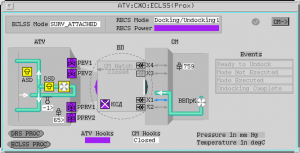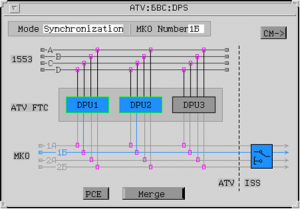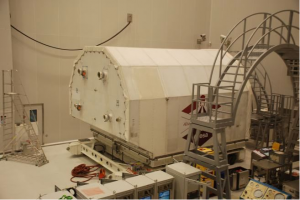ATV-4 Launch planned 18 April 2013 – L–6 months…
25 Sep 2012 – Tuesday
Editor’s note: Part 1 of today’s mission diary update from deputy ATV team manager Charlotte Beskow at ATC-CC Toulouse.
It is Tuesday, and I am sitting in my sunny studio. I have had the day to myself since I am supposed to be sleeping, in advance of my night shift… fat chance! Sleeping in advance is not for me. After a long walk around sunny Toulouse, I had a hearty lunch and retired to my studio to… review the procedures.
[Editor’s note: Charlotte wrote this prior to the now-rescheduled ATV undocking on 25/26 Sep, so the text refers to what was to have happened.]
Yesterday evening, the crew prepared ATV-3 for its final voyage. They secured the 986 kg of return cargo (trash), checked that all valves to the water tanks (which now are loaded with 350 kg of urine) are shut, removed bits and pieces that can be used on the ISS (smoke detectors, lamp housing assemblies) and the fan (to be used as spare for ATV-4). Just before closing the hatch, they removed a manual security barrier for the pyros. These pyros could be used if, for some obscure reason, ATV cannot separate from the ISS. This was one of the few tasks we could ‘watch’ via telemetry.
Once the ATV hatch was closed, the ISS hatch was also closed and the inter-hatch module was depressurised. The final important step of this part of undocking preparations was to perform the leak check, to ensure that the hatches do not leak.
Below you can see the image available to crew on the Russian Service Module (SM) laptop. ATV is to the left and SM is to the right.
All went well and at 21:45, those who were still present satisfied their hunger with pizza (the team leader had forgotten to order meals…).
Now, as I write, my colleagues are busy with the final sequence. Equipment has to be activated according to a strict timeline that has been worked out with our international partners.
Everything is timed from the moment of demerging, i.e. the disconnection of the data bus that connects us with the ISS. As you can see from the diagram, it is a simple switch, but, as usual, reality is a bit more complicated. Communication via the radio link [the Proximity Link – Ed.] has to be set up, and the power connections (not shown here) also need to be disconnected.
The ATV navigation system must be initialised and for this we need position information from the ISS, the propulsion system must be initialised… and so on and so forth.
The actual separation is done by opening the hooks. There are two sets of four hooks, one set on the ISS and one set on the ATV.
The ISS hooks are opened first, then the final preparations are done. Once the ATV hooks are opened, that’s it: this is an irreversible operation. There are springs that will effectively push ATV away at ca. 6 – 9 cm/seconds.
Sensors on the docking interface detect that ATV is no longer there. One minute later, ATV will fire its thrusters, moving the vehicle away from the ISS.
One day later, at a predefined time, ATV thrusters will again be activated and, with a delta speed of 60 – 67 m/seconds (very high!) ATV will aim for a spot in the South Pacific.
Impact will be in the early hours of Thursday morning.
I had planned to give a more detailed account of the various things that occurred between 23 July 23 and now, but the tempo has never slowed down long enough. No sooner did I think that, OK, ‘this evening I will have some time to spare’ than something happened. So, as time is running out (as usual) here is a very brief summary:
- 120723 : HTV3 (Japanese module) berthing to the ISS
120728 : Progress 47P redocking (to test a system)
120730: Progress 47P final undocking
120801: Progress 48P arrival
120802: decision to switch OFF the ATV fan
120806: preparation of water tank 2 to receive waste
120807: undocking simulation (failed due to simulator problem)
120815: reboost (was stopped a little prematurely due to a problem on the Russian side)
120816: first ATV oxygen delivery (with the Fan back ON)
120819: ATV mid mission isolation during Russian EVA (space walk)
120821: activation of complete ATV propulsion system following the incident on Aug 15
120822: reboost with ATV. ISS altitude is now above 400 km for the first time ever
120827: urine transfer into ATV 3 tanks
120824: second oxygen delivery
120830: third oxygen delivery (we carried 67 kg and it is released in steps)
120907: fourth oxygen delivery, tank is almost emptied
120912: HTV3 departs the ISS (with an unexpected abort maneuver)
120914: final ATV reboost of the ISS, we use all the propellant available to ISS
120914: later in the day the final oxygen delivery takes place
120919: Soyuz 30S departs the ISS with three crew members three are left onboard
120920: liquid waste transfer to ATV
120921: final liquid waste transfer to ATV, and final cargo stowage
As you can see the teams have been busy indeed!
And what about ATV-4? Albert Einstein?
In parallel to all of the above activities, ATV-4 has been shipped across the Atlantic. Teams crossed by plane to prepare for its arrival. After a slight hiccup concerning the boat engine (yes – these things do happen), it finally arrived in Kourou harbour and unloading could start. Unpacking takes at least a week but then activities will start in earnest in order to be ready for a launch on 18 Apri next year!!!!!
The cargo carrier half of ATV has arrived in S5B [the first integration building at Europe’s Spaceport in Kourou – Ed.], still in its transport container. The best way to see the difference between the ATVs is the colour of the logo (red on ATV4, green on ATV3 and blue on ATV2).
Most other things stay the same (i.e. the people, the equipment, the rooms… the food…..the stories and, to some extent, the failures!)
That’s it for now!!
— Charlotte






 Automated Transfer Vehicle page
Automated Transfer Vehicle page ATV blog archive
ATV blog archive
Discussion: no comments